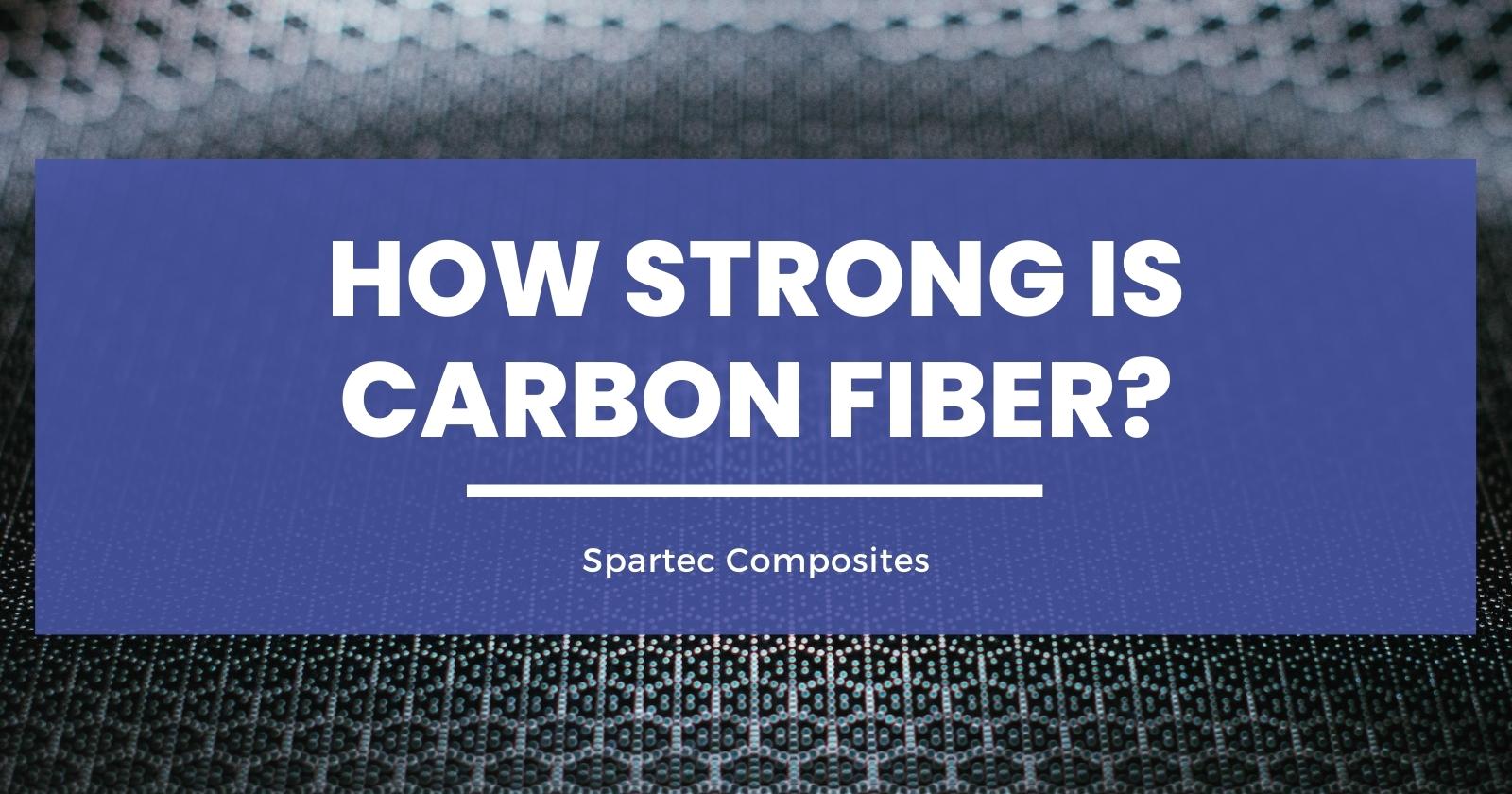
In This Post
- Is Carbon Fiber Stronger than Steel?
- Is Carbon Fiber Stronger than Aluminum?
- Is Carbon Fiber Stronger than a Diamond?
- Is Carbon Fiber Stronger than Plastic?
- Is Carbon Fiber Stronger than Titanium?
- Is Carbon Fiber Stronger than Kevlar®?
- What Makes Carbon Fiber so Strong?
Are you considering choosing carbon fiber as a material for your project but just aren’t quite sure if it is worth the cost? Though it can come at a premium, carbon fiber outperforms many other materials in both strength and lightness. This means that it can be used in a wide variety of applications across many different industries. So, just how strong is carbon fiber? Let’s look to comparing it to other materials to help you understand just how strong carbon fiber can be.
In this post, the experts at Spartec Composites answer some of the most frequently asked questions regarding the strength of carbon fiber. Turn to this resource to help you understand, is carbon fiber stronger than metal, aluminum, diamonds and more. Contact us today to learn more about why carbon fiber might be the best choice for your project. From idea to finished product, our technical expertise and experience make your project come to life.
For more information on what carbon fiber is and how it can be used, see our previous blog post, What is Carbon Fiber and What Can We Use it For?
Is Carbon Fiber Stronger than Steel?
When you think of steel, strength is likely the first thing that comes to mind. Steel is used widely in construction and allows for the creation of high-rise buildings and warehouses. Beyond being used in buildings, steel is also used to create vehicles, construction equipment like cranes, and even railroad tracks. Steel is undisputedly strong and is an essential material that many people use every day despite thinking much of it. With all we know about steel it might seem odd to ask, is carbon fiber stronger than steel however, carbon fiber can be up to ten times strong than steel.
Keep in mind that although carbon fiber can be much stronger than steel, not all carbon fiber is created equally. Also, note that carbon fiber is not always the best choice in place of steel. Carbon fiber is expensive to manufacture and is not always a cost-effective choice. If both strength and lightness are necessary, carbon fiber is an ideal choice. Our previous post, Is Carbon Fiber Stronger than Steel offers additional insight into where carbon fiber can be used and why it could make a better option than steel for some projects.
Is Carbon Fiber Stronger than Aluminum?
Have you ever wondered, is aluminum stronger than carbon fiber? Though it may seem intuitive that all forms of metal would be stronger than a man-made material, that is simply not the case. Not only is carbon fiber stronger than steel, but it is also stronger than aluminum too. Aluminum, like steel, is used in many different products that we use daily. From cans for food and beverages to kitchen products and mechanical parts, aluminum is an important metal that may often be overlooked. Its flexibility is what makes aluminum unique and allows it to be used across a variety of applications. However, aluminum is not stronger than carbon fiber, nor is it lighter.
Aluminum may still be the appropriate choice for your project as strength is not the only factor that needs to be considered. Though carbon fiber is stronger than aluminum, it is not as ductile and is less affordable. Be sure to explore all the requirements of your project before settling on one material. Our composite engineering experts help you choose the best material for your needs through our in-house design process.
Is Carbon Fiber Stronger than a Diamond?
Diamonds are known for their beauty but also hardness too. Though diamonds are generally not thought of as being anything but a shiny rock, they can also have industrial applications too. Due to their hardness, diamonds have been used as cutting tools, and some may wonder if other materials such as carbon fiber may be a stronger option. Though incredibly strong, carbon fiber is not necessarily as hard as a diamond. This means it is simply suitable for different applications that a diamond would be. It is difficult to compare a diamond to carbon fiber as they are intended for different uses; however, both can be used in jewellery depending on the desire of the intended wearer.
Is Carbon Fiber Stronger than Plastic?
Plastic comes in many different forms, and its strength can be hard to capture under one blanket term. Consider that in your daily life, you likely encounter flexible plastics such as water bottles and hard plastics like the plastic on a pen, yet these materials are all considered to be “plastic.” Like carbon fiber, different types of plastic can be stronger than others. Reinforced plastics can offer incredible durability and may be a suitable option for many types of projects, though carbon fiber is overall the stronger material. Keep in mind that plastics can be reinforced with carbon fiber making it an incredibly strong material that can be used in manufacturing, automotive and aerospace industries.
Is Carbon Fiber Stronger than Titanium
Titanium is a lightweight and incredibly strong metal that is used in products we use daily such as bike frames, sports equipment, and prosthetics. Many of the uses for titanium are also common uses for carbon fiber products. If you’ve ever wondered, is titanium stronger than carbon fiber, the answer depends on the quality of the carbon fiber in question. Carbon fiber can be both stronger and lighter than titanium; however, the carbon fiber itself must be strong. Carbon fiber can be made to be stronger than many metals and is often a top choice when strength is a requirement, however not all carbon fibers can be classified as stronger than titanium. Be sure to work with an experienced composites fabricator when sourcing carbon fiber for a project. There are many variables that should be considered during the process of manufacturing a carbon fiber product, and carbon fiber may not always be the optimal choice.
Is Kevlar® Stronger than Carbon Fiber?
Much like other materials, knowing whether Kevlar® is stronger than carbon fiber depends on the quality and strength of the carbon fiber material in question. High-quality carbon fiber can be stronger than Kevlar® though the comparison is not a straightforward one. Kevlar® is used in different applications that carbon fiber would generally be used for. As Kevlar® is lighter and more flexible than carbon fiber, it can be used in different applications. Overall, carbon fiber may be stronger than Kevlar® however, as with most projects, the functional requirements of the finished product will determine which material is ideal rather than overall strength.
Our previous blog post, Carbon Fiber vs. Kevlar®, Which is Better, offers additional insight into the difference between these materials, including why one might be a better choice than another based on the intended use of the product.
What Makes Carbon Fiber so Strong
There is no disputing that carbon fiber can be the ideal material option when strength and lightness are a requirement. But why is carbon fiber strong, and why does the strength of the material vary from product to product? The easiest way to understand carbon fiber is to know that it is a composite material, meaning it is made up of more than one type of material. For this reason, carbon fiber can be custom fabricated to suit the unique needs of your project.
Generally speaking, carbon fibers consists of 90% polyacrylonitrile (PAN), with the other 10% being rayon or petroleum pitch. Combined, these materials create a lightweight material that can be used for sporting equipment, medical devices, automobile and aerospace parts, construction and more. The strength of carbon fiber can vary based on how it is fabricated. Navigating the world of carbon fiber composites can feel overwhelming. Know that by choosing Spartec Composites for your composite manufacturing needs, you can be assured of quality and performance based on the demands of your project.
See our previous blog post, Common Questions about Carbon fiber, to learn more about why carbon fiber is a strong and versatile material. Contact us today to learn more about how you can take your project from idea on paper to finished product all in one location with our in-house engineering and manufacturing teams.





